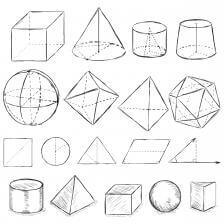What Are Polygons?
What do a triangle, a rectangle, and a pentagon all have in common? They’re all polygons. What makes a polygon a polygon? And why do they matter? Keep on reading to find out!

Answer: polygon.
Ha!
OK, so it’s not exactly the greatest joke in the world, but geometry is not exactly a hilarious subject. Beautiful, elegant, perhaps picturesque, but not traditionally full of funny. So we can’t be too picky, can we?
The word polygon is probably one of those words you know you’ve heard before, but you’re really not sure where that was, when that was, or what it actually meant. Sure, you probably have an intuitive feeling that polygons have something to do with geometry and shapes, but what exactly?
Lucky for you, that’s exactly what we’re talking about today.
Sponsor: This episode is brought to you by NatureBox. Discover smarter snacking with a new NatureBox each month. Get your first box FREE when you go to naturebox.com/qdt.
What Is a Polygon?
The logical way to begin our look at the mighty polygon is to first figure out what the word “polygon” means. A lot of you will be familiar with the first part of this word—poly—which derives from the Greek word for “many.” So a polygon is many somethings…but what?
Of course, that’s where the “gon” part of polygon comes into the story. In particular, “gon” is part of a Greek word that means “angle” or “corner.” So polygon means “many angles” or “many corners.” And that’s exactly what geometric shapes known as polygons contain.
Polygon means “many angles” or “many corners.”
A bit more formally, a polygon is defined as any closed two-dimensional shape made up of several straight line segments (and thus also many corners). The “closed” part of this definition means that the line segments must eventually come around and connect together to form a closed chain. The two-dimensional part means that polygons must lie entirely in a flat plane like a sheet of paper.
Importantly, all of the line segments in a polygon must be straight…they can’t be curved. So a circle—or any other curved shape—is not a polygon.
And that’s it! Each and every one of the myriad shapes that satisfy these conditions is a polygon.
Regular and Irregular Polygons
There are lots of ways to further break up the infinite variety of all possible polygons into different categories. One important distinction is made between what are known as regular and irregular polygons.
Polygons whose sides are all equal in length and whose angles are all equal in size are known as regular polygons. These are some of your favorites. The three equal sides and angles of an equilateral triangle, the four equal sides and angles of a square, the five equal sides and angles of a pentagon, the six equal sides and angles of a hexagon, and so on, mean that all of these shapes we know and love are regular polygons.
Of course, not all polygons are regular. For example, rectangles, rhombuses, most of the triangles in the universe (besides equilaterals), and a whole mishmash of other possible polygonal shapes are irregular if their sides and/or angles are not all equal.
In the world of all possible polygons, irregular is actually the norm—it’s the few-and-far-between very special regular polygons that are actually the oddballs.
Simple and Complex Polygons
Objects in the polygonal zoo are further broken down into two additional types: simple and complex. In a simple polygon, no line segment ever cross over one of its buddy line segments that’s part of the same polygon. In a complex polygon, line segments can cross over each other as much as they’d like.
All regular polygons are simple polygons.
If you think about it, you’ll see that all regular polygons are simple polygons. In other words, they don’t intersect themselves and therefore have only a single boundary dividing their “insides” from their “outsides.”
A star-shaped polygon (with all of the criss-crossing line segments left intact) such as a pentagram is an example of a complex polygon. It still satisfies all the requirements to be in the polygonal club—namely it’s a closed shape made from a bunch of straight lines in a plane—but it’s certainly not a simple one…literally.
Polygons in the Real World
Now that your memory has been jogged and you remember that yes indeed you did once-upon-a-time learn what a polygon is, you might be wondering: So what? Why do polygons matter to you, me, and the rest of the world?
Let’s start with the rest of the world—by which I mean nature. Because it turns out that polygons actually show up in the natural world.
Where might you see one in the wild? Well, there’s the hexagonal pattern of honeycombs, the somewhat mysterious hexagonally shaped storm on Saturn, the triangular or square or even more complex faces of naturally occurring crystals, and then there’s the truly bizarre and oh-so-remarkably hexagonal pillars of rock found at the Giant’s Causeway in Northern Ireland and Devil’s Postpile in California.
For me, the fact that polygons show up in nature, combined with the fact that they have tons and tons of fascinating mathematical properties (which we haven’t even begun to scratch the surface of), is more than enough reason to declare that in our world they definitely matter. Don’t you think?
Wrap Up
OK, that’s all the polygon pandemonium we have time for today. But there’s a lot more to say about polygons—so be sure to check back in the future for more.
Following up on our last two Martin Gardner puzzle episodes, if you haven’t yet taken a look at Scientific American’s Martin Gardner tribute page, I highly recommend doing so. And while you’re there, you can also pick up a copy of the ebook, Martin Gardner: The Magic and Mystery of Numbers—it’s an awesome collection of Mr. Gardner’s most popular mathematical games and puzzles.

Until next time, this is Jason Marshall with The Math Dude’s Quick and Dirty Tips to Make Math Easier. Thanks for reading, math fans!
Geometric shapes and triangle image courtesy of Shutterstock.








